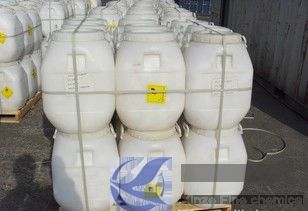Calcium hypochlorite, also known as high-efficiency bleaching powder, is mainly composed of calcium hypochlorite. According to different production processes, it also contains calcium chloride, sodium chloride and calcium hydroxide. Its effective chlorine content is more than 60%. Bleaching powder concentrate has strong sterilization, disinfection, purification and bleaching effect, and has a wide range of applications in wool washing, textile, carpet, paper and other industries. It is mainly produced by the reaction of calcium hypochlorite with water and carbon dioxide to produce strong oxidizing hypochlorite. The stain is removed by hypochlorite.
Alias: calcium hypochlorite; high-efficiency bleaching powder; calcium trichloride with calcium dihydroxide [1]
Chemical formula: 3Ca(ClO)2.2Ca(OH)2
Molecular weight: 577.0
CAS: 7778-54-3
Properties: White powder or granule. There is a strong chlorine odor. It has corrosiveness and strong oxidation. Easy to dissolve in cold water. It is decomposed in hot water and ethanol. Heating decomposes rapidly and causes explosions. The chlorine gas is released by the reaction with acid, and reacts with organic matter and oil to cause combustion. It is easy to explode and decompose when exposed to light, resulting in oxygen and chlorine.
Application: Mainly used for bleaching cotton fabric, linen fabric, pulp, etc. Its disinfection and sterilization are widely used in drinking water, swimming pool water purification, silkworm rearing and so on. It is also used in the manufacture of chemical poisonous gases and radioactive disinfectants. In addition, it is also used in the pharmaceutical industry.
Attention should be paid to the problem of preservation: sealed in the dark
Cause of sealed storage: Because bleaching powder is mainly Ca (ClO) 2, CaCl 2, Ca (ClO) 2 is the useful ingredient, and HCLO is the role.
Ca(ClO)2+H_2+CO_2_CaCO_3+2HClO_2HClO_2HCl+O_2_will occur if it is not sealed.
is dark because HCLO light decomposes 2HClO_2HCl+O2_
Usually used for disinfection and sterilization and water treatment, chemical poisons, radioactive substances disinfection. The stability is particularly good. It can be stored for a long time at room temperature. The loss of available chlorine content is less and the solubility is high. It is easy to dissolve in water to form a high concentration bleaching solution with less insoluble substances and 60%-70% content.
Use of bleaching powder concentrate:
It is used for bleaching oars, silk, cloth, fibers, disinfection, sterilization and water treatment. Chemical poisons, disinfectants for radioactive substances. This product is a broad-spectrum disinfectant, bactericide and deodorant for external use. It is widely used in disinfection of drinking water, hotels, hotels and hospitals. For disinfection of baths and swimming pools. It is used for disinfection of food processing factories and dairy farms. Applicable to infectious diseases, as a routine disinfection preventive disinfection and environmental disinfection in various public places. It can be used for silkworm rearing, livestock and poultry, fish rearing, disinfection, shrink-proof finishing of wool, bleaching of textile industry, algae removal of industrial circulating water and rubber chlorinating agent.
Application of bleaching powder concentrate
1. 100 Kg 65% bleaching powder concentrate added to 1 ton of water can be prepared into 6.5% effective chlorine bleaching solution.
2. 1 ton of water with 1.7 g bleaching powder concentrate can be used to prepare disinfection water containing one millionth of available chlorine.
The bleaching powder concentrate has the following advantages:
1. High content of available chlorine.
 2. It has good stability and can be preserved for a long time at room temperature with less loss of available chlorine content.
2. It has good stability and can be preserved for a long time at room temperature with less loss of available chlorine content.
3. High solubility, easy to dissolve in water to form high concentration bleaching solution, less insoluble matter.
Use precautions
1. Store in a well-ventilated place, away from heat sources, and avoid direct sunlight exposure.
2. No exposure to sunlight, heat or moisture during transportation, and no contact with organic, oil or acid substances.
3. Disposal methods for packaging damage and leakage: timely collection and sealing.
4. Rinse skin burns with water or dilute ammonia.
Fire fighting methods
Yellow sulphuric acid, carbon dioxide and foam fire extinguishers must not be used in general sulfuric acid fire extinguishers.